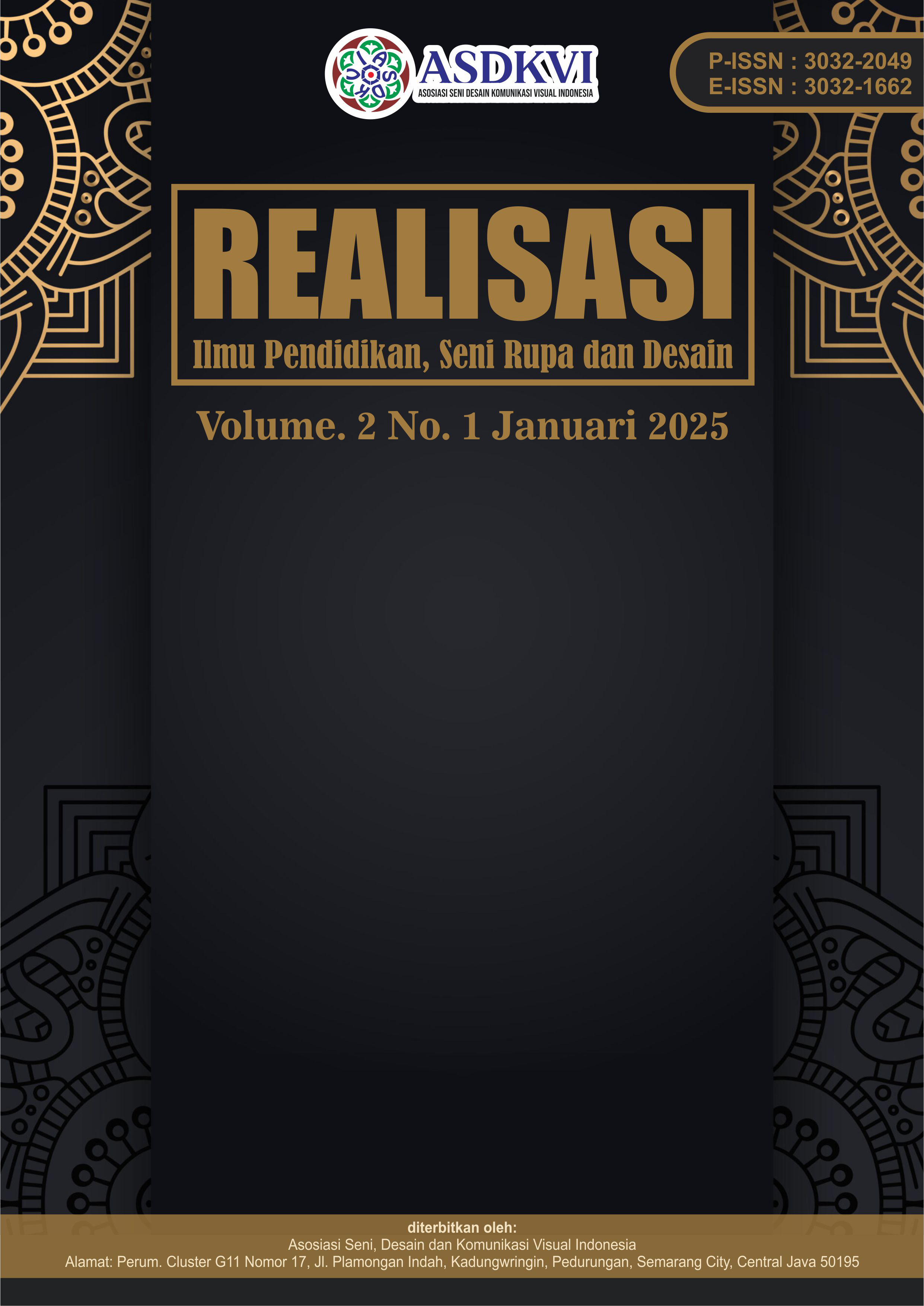Penciptaan Dress Lilit Motif Bunga Easter Lily Dengan Teknik Batik Tulis
DOI:
https://doi.org/10.62383/realisasi.v2i2.582Keywords:
Batik, Easter lily Motif, Wrapped Dress, Hand-drawn BatikAbstract
This creation is based on Batik as a rich Indonesian cultural heritage, which continues to undergo significant transformation by combining traditional elements and modern fashion trends. The creation of a new batik motif inspired by the Easter lily flower, was chosen because of its symbolic meaning and natural beauty. The design of this motif consists of three elements: the main motif of the Easter lily flower, supporting motifs, and isen motifs as complementary details. This creation aims to determine the process and results of applying Easter lily motif batik cloth to a wrap Dress using the batik tulis technique. This creation uses the Alma M. Hawkins method which has 5 stages of creation, namely: preparation, elaboration, synthesis, concept realization, and completion. The result of this creation is the creation of a wrap Dress with an Easter lily flower motif of 12 batik works. This batik tulis uses the colet technique with remasol dye. The wrap batik Dress with the Easter lily motif is expected to foster the interest of the younger generation in wearing batik tulis with colors and motifs that are tailored to their tastes.
References
Atmojo, W. T. (2017). Ulos and batik as the identity of nation. BKS PTN Wilayah Barat Fields of Linguistics, Literature, Art and Culture, 200–203.
Atmojo, W. T. (2020). Eksplorasi kearifan lokal: Ornamen Sumatra Utara. Medan: CV Kencana Emas Sejahtera.
Atmojo, W. T. (2024). Creation of signature batik from North Sumatra ethnicity. Environment-Behaviour Proceedings Journal, 9(SI23), 127–133.
Atmojo, W. T., Hidayat, Misgiya, & Dallion, R. (2023). Desain inovasi batik motif Deli Serdang bagi guru-guru seni budaya tingkat SMP di Dinas Pendidikan Kabupaten Deli Serdang. Dalam Seminar Nasional Pengabdian kepada Masyarakat, Seminar dalam Jaringan LPPM Universitas Negeri Medan (hlm. 217–225). UNIMED Publisher.
Bandem, I. M. (2001). Metodologi penciptaan seni: Kumpulan mata kuliah. Yogyakarta: Program Pascasarjana ISI Yogyakarta.
Bliss, H. E. (1929). The organization of knowledge and the system of the sciences. New York: Henry Holt and Company.
Darmansa, J. N., Haldani, A., & Tresnadi, C. (2019). Identifikasi minat generasi Z terhadap ragam hias batik Belanda. Jurnal Sosioteknologi, 18(2), 232–241.
Doellah, H. S. (2002). Batik: Pengaruh zaman dan lingkungan. Solo: Batik Danar Hadi.
Hawkins, A. (1964). Creating through dance. New Jersey: Prentice Hall Inc.
Kusumawardhani, R. (2017). Step by step 45 gaya mari berkain. Jakarta: Gramedia Pustaka Utama.
Lisbijanto, H. (2013). Batik. Yogyakarta: Graha Ilmu.
Mandegani, G. B., Susanto, T., & Nugroho, A. (2018). Persepsi kualitas batik tulis. Dinamika Kerajinan dan Batik, 35(2), 75–84.
Nilawati, E. S. (2011). Pesona bisnis batik yang unik dan eksotik. Yogyakarta: CV Andi Offset.
Nugroho, H. (2020). Pengertian motif batik dan filosofinya. Jakarta Selatan: Kementerian Perindustrian Republik Indonesia.
Pranata, A. (2014). Mengenal kriya batik Nusantara. Medan.
Prayitno, T. (2020). Mengenal produk nasional batik dan tenun. Semarang: PT Sindur Press.
Qoimah, H. (2012). Karakteristik batik motif Sekar Jagad Yogyakarta (Skripsi). Fakultas Bahasa dan Seni, Universitas Negeri Yogyakarta, Yogyakarta.
Rahmawati, I. (2022). A to Z batik for fashion. Bekasi: Laskar Aksara.
Rhosyana, C. (2016). Rempah-rempah (cengkih, lada, dan pala) sebagai ide pembuatan motif batik tulis untuk busana ikat lilit. Pendidikan Seni Kerajinan–S1 (e-Craft), 5(3), 1–9.
Smend, R., & Harper, D. (2011). Batik: Traditional textiles of Indonesia. Jepang: Tuttle Publishing.
Suhaeni, E. (2017). Teratai sebagai ide penciptaan motif batik untuk dress remaja putri. Pendidikan Seni Kerajinan–S1 (e-Craft), 6(7), 656–665.
Super You. (2024, Januari 2). 8 arti bunga lily berdasarkan warna dan jenisnya. https://superyou.co.id
Utami, R. (2014). Ensiklopedia batik dan kain hias Nusantara. Bandung: Angkasa.
Wulandari, A. (2011). Batik Nusantara. Yogyakarta: Penerbit Andi.
Yulianingrum, V., Fadlilah, A. N., & Khasanah, U. (2022). Batik fashion trends and national identity. Philosophica: Jurnal Bahasa, Sastra, dan Budaya, 5(2), 46–58.
Downloads
Published
How to Cite
Issue
Section
License
Copyright (c) 2025 Realisasi : Ilmu Pendidikan, Seni Rupa dan Desain

This work is licensed under a Creative Commons Attribution-ShareAlike 4.0 International License.





